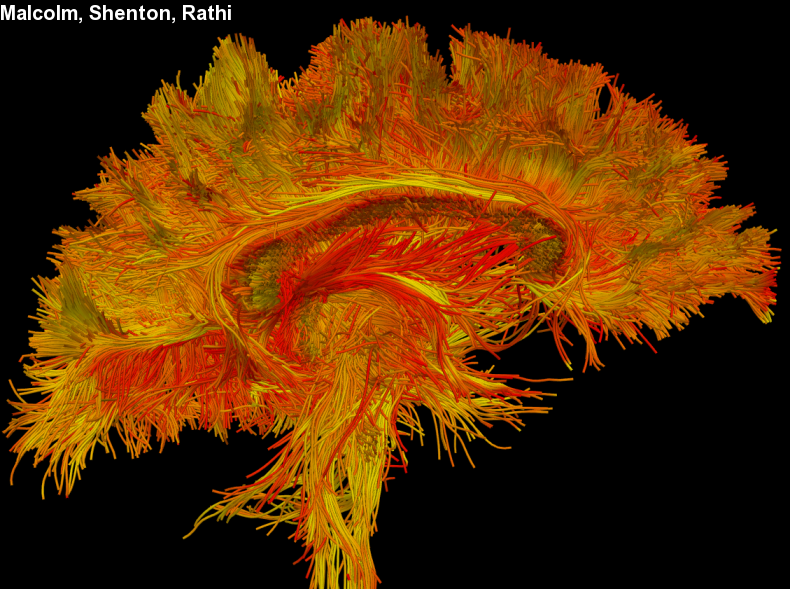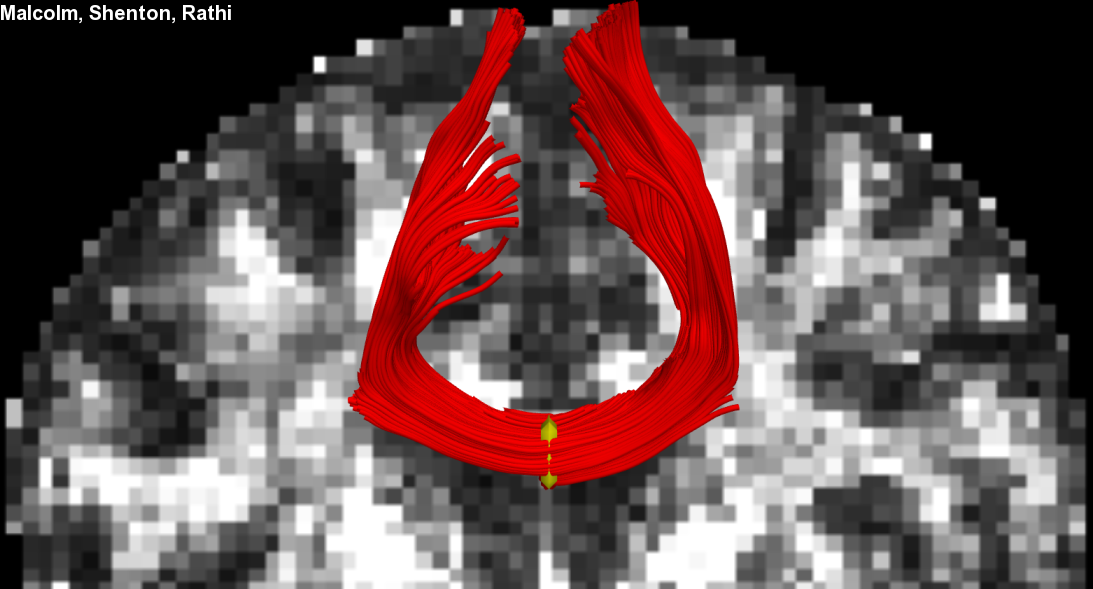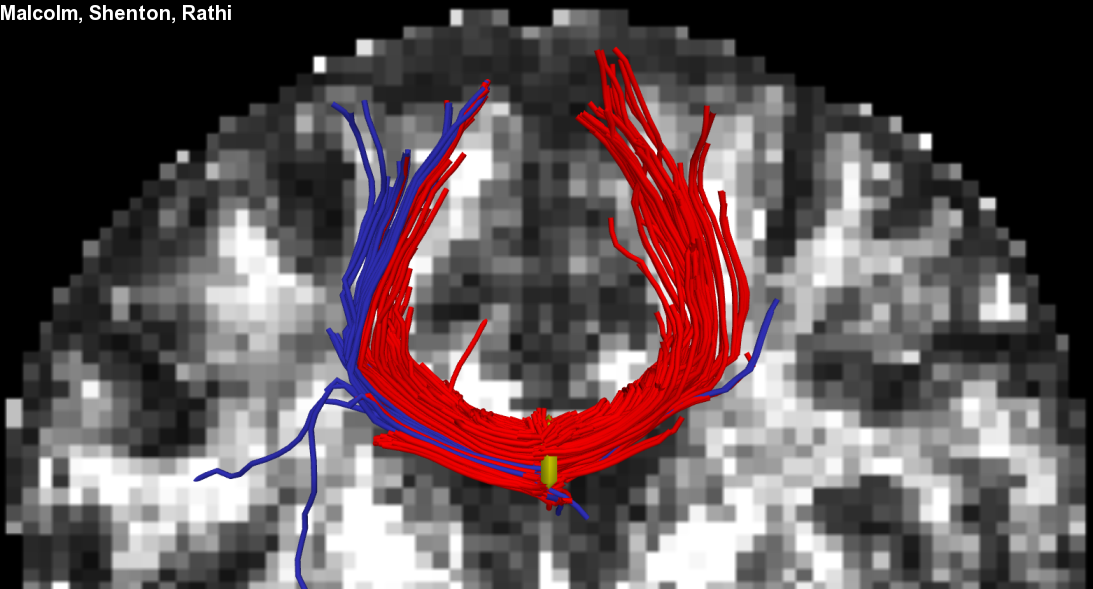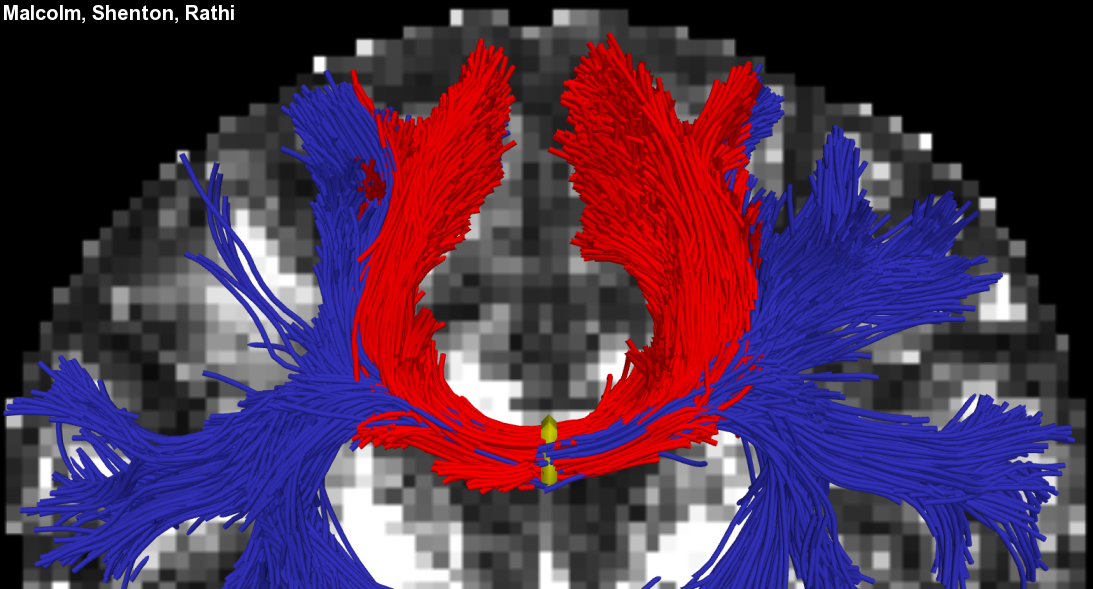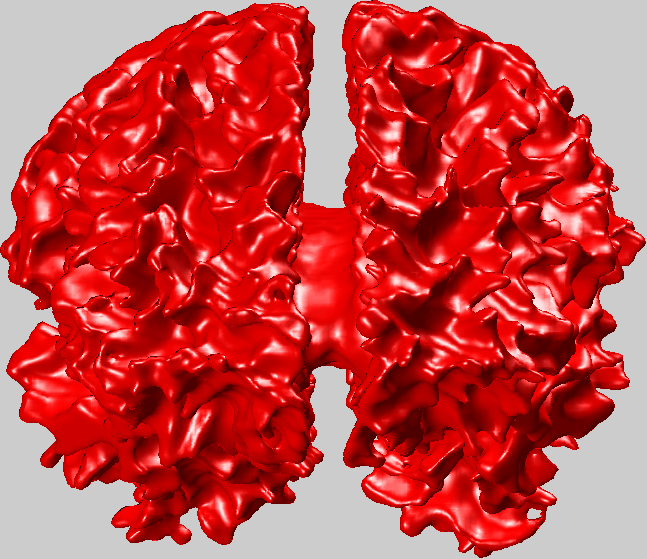Research Projects
Below are descriptions of various projects I pursued. There are also a list of publications, curriculum vitae, and software downloads associated with this work.
Filtered Neural Tractography
Many techniques for tracing out neural fiber pathways estimate the local fiber orientation independently at each voxel, so there is no running knowledge of confidence in the estimated model parameters. In this work, we formulate fiber tracking as recursive estimation: at each step of tracing the fiber, the current estimate is guided by the previous. Despite the presence of noise and uncertainty, this provides a causal estimate of the local structure at each point along the fiber.
To handle crossings and branchings of multiple fiber pathways, we model the local signal as a mixture of tensors. Starting from a seed point, each fiber is traced to its termination using an unscented Kalman filter (UKF) to simultaneously fit the local model and propagate in the most consistent direction. Within this filtering framework, path regularization is inherent and estimation adapts to the level of noise present in the signal.
Synthetic experiments demonstrate that this approach significantly improves the angular resolution at crossings and branchings. In vivo experiments confirm the ability to trace out fibers in areas known to contain such crossing and branching. Many of these known pathways were not revealed with single-tensor tractography.
“Processing and Visualization of Diffusion MRI”, Malcolm, Rathi, Westin, Recent Advances in Biomedical Image Processing and Analysis, T. Deserno (Editor), Chapter 16, pages 387-410, 2011. [bib]
“Filtered multi-tensor tractography”, Malcolm, Shenton, Rathi, IEEE Trans. in Medical Imaging (TMI), 29(9), pages 1664-1675, 2010. [bib]
“Filtered tractography”, Malcolm, (PhD dissertation), October 2010. [slides, bib]
“Two-Tensor Tractography Using a Constrained Filter”, Malcolm, Shenton, Rathi, Medical Image Computing and Computer Assisted Intervention (MICCAI), pages 894-902, 2009. [poster, bib]
“Neural Tractography Using An Unscented Kalman Filter”, Malcolm, Shenton and Rathi, Information Processing in Medical Imaging (IPMI), 2009. [slides]
“Mixture Model for estimating fiber ODF and multi-directional Tractography”, Rathi, Malcolm, Bouix, Kindlmann, Westin, Kubicki, Shenton, Intl. Soc. of Magnetic Resonance in Medicine (ISMRM), 2009. [slides]
Label Space

Many techniques for multi-shape representation may often develop inaccuracies stemming from either approximations or inherent variation. Label space is an implicit representation that offers unbiased algebraic manipulation and natural expression of label uncertainty. We demonstrate smoothing and registration on multi-label brain MRI.
“Label Space: A Coupled Multi-Shape Representation”, Malcolm, Rathi, Shenton, Tannenbaum, Medical Image Computing and Computer Assisted Intervention (MICCAI),
- Runner-Up, MICCAI Young Scientist Award [slides]
“Label Space: A Multi-Object Shape Representation”, Malcolm, Rathi, Tannenbaum, Combinatorial Image Analysis, 2008.
“Affine registration of label maps in Label Space”, Rathi, Malcolm, Bouix, Tannenbaum, Shenton, J. of Computing, 2(4), pages 1-11, 2010. [bib]
“Segmenting Images Analytically in Shape Space”, Rathi, et al., IS&T/SPIE Symposium on Medical Imaging, 2008.
Level set methods
In many situations the regional statistics of the object of interest are unknown. In such cases one approach is to separate an object from its background measuring their statistical difference with the Bhattacharyya metric. Download the MATLAB code for these techniques.
Further, the numerical considerations of the level set method often prohibit its use high performance applications which has driven our development of an efficient and flexible algorithm for curve evolution.
“Seeing the Unseen: Segmenting with Distributions”, Rathi, Michailovich, Malcolm, Tannenbaum, Intl. Conference on Signal and Image Processing (SIP), 2006.
“Fast Approximate Surface Evolution in Arbitrary Dimension”, Malcolm, Rathi, Yezzi, Tannenbaum, IS&T/SPIE Symposium on Medical Imaging, 2008. [slides, poster]
“Closed Loop Visual Tracking Using Observer-Based Dynamic Active Contours”, Vela, Niethammer, Malcolm, Tannenbaum, Conf. on Guidance, Navigation, and Control, 2005.
“Vision-Based Range Regulation of a Leader-Follower Formation”, Vela, Betser, Malcolm, Tannenbaum, IEEE Transactions on Control Systems Technology, 17(2):442-448, 2009
“Localized statistics for DW-MRI fiber bundle segmentation”, Lankton, Melonakos, Malcolm, Dambreville, Tannenbaum, MMBIA, 2007. [poster]
Multi-object tracking with graph cuts
The standard graph cut technique quickly captures objects anywhere in the image; however, because of its global nature, it is prone to capturing outlying areas similar to the object of interest. This work proposes a method to constrain the standard graph cut technique to regions of interest for tracking multiple interacting objects. Download the MATLAB package for graph cut image segmentation (Win32, Mac, Linux32, Linux64).
“Tracking Through Clutter Using Graph Cuts”, Malcolm, Rathi, Tannenbaum, British Machine Vision Conference (BMVC), 2007. [poster].
“Multi-Object Tracking Through Clutter Using Graph Cuts”, Malcolm, Rathi, Tannenbaum, Workshop on Non-rigid Registration and Tracking through Learning (in ICCV), 2007. [slides].
Graph cuts with shape priors
Graph cut image segmentation with intensity information alone is prone to fail for objects with weak edges, in clutter, or under occlusion. We show how learned shape priors can be added to existing iterative graph cut methods for accurate and efficient segmentation of such objects. Using kernel principle component analysis, we demonstrate how a shape projection pre-image can induce an iteratively refined shape prior in a Bayesian manner. Download the MATLAB wrapper for graph cut image segmentation (Win32, Mac, Linux32, Linux64).
“Graph cut segmentation with nonlinear shape priors”, Malcolm, Rathi, Tannenbaum, Int. Conf. on Image Processing (ICIP), 2007. [poster].
Graph cuts in tensor space
Often intensity alone does not provide enough discriminating power for image segmentation. This work demonstrates extending the standard graph cut technique to more discriminative feature spaces. One such space is formed from the tensor products of feature vectors incorporating intensity, image derivatives, etc. Download the MATLAB package for graph cut image segmentation (Win32, Mac, Linux32, Linux64).
“A Graph Cut Approach to Image Segmentation in Tensor Space”, Malcolm, Rathi, Tannenbaum, Workshop on Component Analysis Methods (in CVPR), 2007. [slides]
Quantum error correction
Quantum computers promise to solve many problems considered practically impossible using today’s classical computers. However, in constructing such devices, errors are introduced into the systems as the unstable subatomic components interact with their environment. Careful encoding of quantum data protects against such errors.
In this report we briefly cover the development of classical error correcting codes and define several concepts that will lead us to the development of analogous techniques for quantum systems. Included is a survey of several advanced codes and discussion of future directions for fault tolerant quantum computation.
“Quantum error correction”, Malcolm, final report for Math4782.
Software Downloads
- graphchop - Multi-label graph cut image segmentation
- levelsets - Level set (active contour) image segmentation

